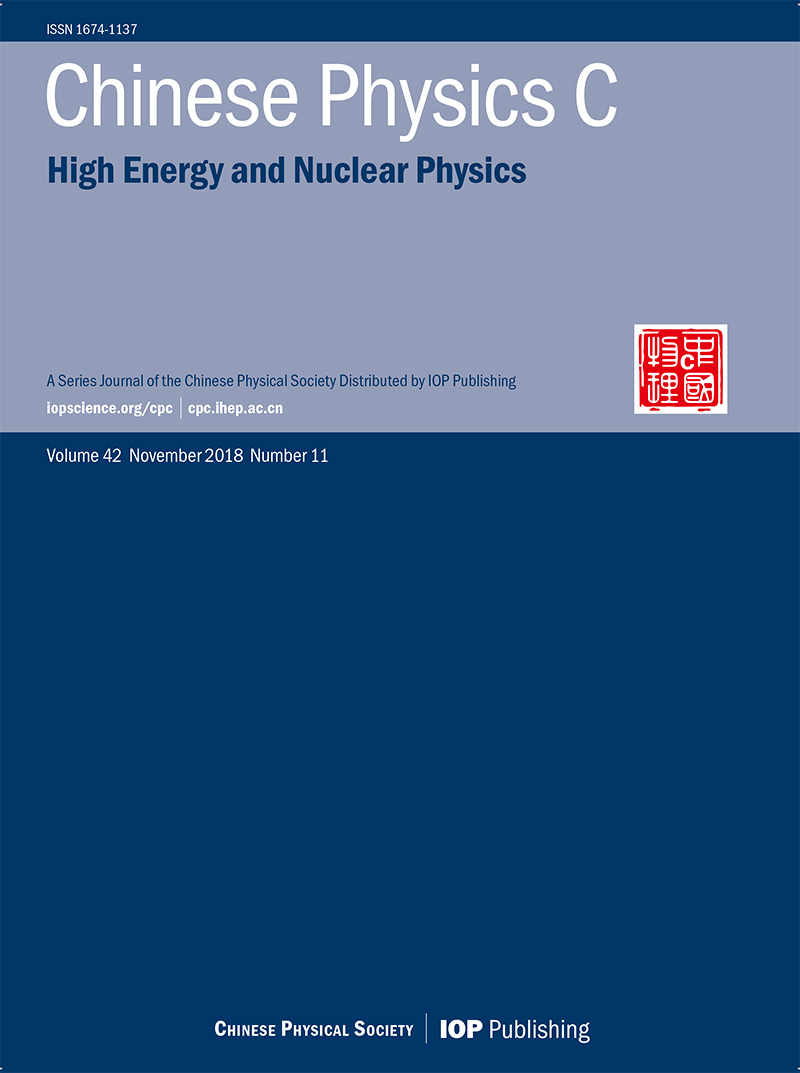2020 Vol. 44, No. 3
Display Method: |
2020, 44(3): 031001. doi: 10.1088/1674-1137/44/3/031001
Abstract:
We emphasize that it is extremely important for future neutrinoless double-beta (\begin{document}$0\nu\beta\beta$\end{document} ![]()
![]()
\begin{document}$|m_{\beta\beta}| \approx 1\;{\rm {meV}}$\end{document} ![]()
![]()
\begin{document}$0\nu\beta\beta$\end{document} ![]()
![]()
\begin{document}$|m_{\beta\beta}| \approx 1\;{\rm {meV}}$\end{document} ![]()
![]()
\begin{document}$0\nu\beta\beta$\end{document} ![]()
![]()
\begin{document}$m_1$\end{document} ![]()
![]()
\begin{document}$\{\rho, \sigma\}$\end{document} ![]()
![]()
\begin{document}$m_1 \in [0.7, 8]\;{\rm {meV}}$\end{document} ![]()
![]()
\begin{document}$m_2 \in [8.6, 11.7]\;{\rm {meV}}$\end{document} ![]()
![]()
\begin{document}$m_3 \in [50.3, 50.9]\;{\rm {meV}}$\end{document} ![]()
![]()
\begin{document}$\rho \in [130^\circ, 230^\circ]$\end{document} ![]()
![]()
\begin{document}$\Sigma \equiv m_1 + m_2 + m_3 \in [59.2, 72.6]\;{\rm {meV}}$\end{document} ![]()
![]()
\begin{document}$m_\beta \equiv (|U_{e1}|^2 m^2_1 + |U_{e2}|^2 m^2_2 + |U_{e3}|^2 m^2_3)^{1/2}\in [8.9, 12.6]\;{\rm {meV}}$\end{document} ![]()
![]()
We emphasize that it is extremely important for future neutrinoless double-beta (
2020, 44(3): 031002. doi: 10.1088/1674-1137/44/3/031002
Abstract:
A symmetry-preserving continuum approach to the two valence-body bound-state problem is used to calculate the valence, glue and sea distributions within the pion; unifying them with, inter alia, electromagnetic pion elastic and transition form factors. The analysis reveals the following momentum fractions at the scale\begin{document}$\zeta_2:=2\,{\rm{GeV:}}\langle x_{\rm valence} \rangle = 0.48(3)$\end{document} ![]()
![]()
\begin{document}$\langle x_{\rm glue} \rangle = 0.41(2)$\end{document} ![]()
![]()
\begin{document}$\langle x_{\rm sea} \rangle = 0.11(2)$\end{document} ![]()
![]()
\begin{document}$q^\pi(x)$\end{document} ![]()
![]()
\begin{document}$x\simeq 1$\end{document} ![]()
![]()
\begin{document}$\zeta=5.2\,{\rm{GeV}}$\end{document} ![]()
![]()
\begin{document}$q^\pi(x)$\end{document} ![]()
![]()
A symmetry-preserving continuum approach to the two valence-body bound-state problem is used to calculate the valence, glue and sea distributions within the pion; unifying them with, inter alia, electromagnetic pion elastic and transition form factors. The analysis reveals the following momentum fractions at the scale
2020, 44(3): 033001. doi: 10.1088/1674-1137/44/3/033001
Abstract:
The research on geoneutrinos is a new interdisciplinary subject involving particle experiments and geo-science. Potassium-40 (40K) decays contribute roughly to 1/3 of the radiogenic heat of the Earth, which is not yet accounted for by experimental observation. Solar neutrino experiments with liquid scintillators have observed uranium and thorium geoneutrinos and are the most promising experiments with regard to low-background neutrino detection. In this study, we present the new concept of using liquid-scintillator Cherenkov detectors to detect the neutrino-electron elastic scattering process of 40K geoneutrinos. Liquid-scintillator Cherenkov detectors using a slow liquid scintillator achieve this goal with both energy and direction measurements for charged particles. Given the directionality, we can significantly suppress the dominant intrinsic background originating from solar neutrinos in conventional liquid-scintillator detectors. We simulated the solar- and geo-neutrino scatterings in the slow liquid scintillator detector, and implemented energy and directional reconstructions for the recoiling electrons. We found that 40K geoneutrinos can be detected with three-standard-deviation accuracy in a kiloton-scale detector.
The research on geoneutrinos is a new interdisciplinary subject involving particle experiments and geo-science. Potassium-40 (40K) decays contribute roughly to 1/3 of the radiogenic heat of the Earth, which is not yet accounted for by experimental observation. Solar neutrino experiments with liquid scintillators have observed uranium and thorium geoneutrinos and are the most promising experiments with regard to low-background neutrino detection. In this study, we present the new concept of using liquid-scintillator Cherenkov detectors to detect the neutrino-electron elastic scattering process of 40K geoneutrinos. Liquid-scintillator Cherenkov detectors using a slow liquid scintillator achieve this goal with both energy and direction measurements for charged particles. Given the directionality, we can significantly suppress the dominant intrinsic background originating from solar neutrinos in conventional liquid-scintillator detectors. We simulated the solar- and geo-neutrino scatterings in the slow liquid scintillator detector, and implemented energy and directional reconstructions for the recoiling electrons. We found that 40K geoneutrinos can be detected with three-standard-deviation accuracy in a kiloton-scale detector.
2020, 44(3): 033101. doi: 10.1088/1674-1137/44/3/033101
Abstract:
Neutron-antineutron (\begin{document}$ n-\bar n $\end{document} ![]()
![]()
\begin{document}$ n-\bar n $\end{document} ![]()
![]()
\begin{document}$ \tau_{n-\bar n} $\end{document} ![]()
![]()
\begin{document}$ NN $\end{document} ![]()
![]()
\begin{document}$ \bar NN $\end{document} ![]()
![]()
\begin{document}$ (2.6\pm 0.1) \times 10^{22}\,\tau^2_{n-\bar n} $\end{document} ![]()
![]()
Neutron-antineutron (
2020, 44(3): 033102. doi: 10.1088/1674-1137/44/3/033102
Abstract:
Tensor reduction is of considerable importance in calculations of multi-loop amplitudes, and the projection method is one of the most popular approaches for tensor reduction. However, the projection method can be problematic when applied to amplitudes with massive fermions, due to the inconsistency between helicity and chirality. We propose an extended projection method for reducing the loop amplitude which contains a fermion chain with two massive spinors. The extension is achieved by decomposing one of the massive spinors into two massless spinors, the “null spinor” and the “reference spinor”. The extended projection method can be effectively applied in all processes, including the production of massive fermions. We present the tensor reduction for a virtual Z boson decaying into a top-quark pair as a demonstration of our approach.
Tensor reduction is of considerable importance in calculations of multi-loop amplitudes, and the projection method is one of the most popular approaches for tensor reduction. However, the projection method can be problematic when applied to amplitudes with massive fermions, due to the inconsistency between helicity and chirality. We propose an extended projection method for reducing the loop amplitude which contains a fermion chain with two massive spinors. The extension is achieved by decomposing one of the massive spinors into two massless spinors, the “null spinor” and the “reference spinor”. The extended projection method can be effectively applied in all processes, including the production of massive fermions. We present the tensor reduction for a virtual Z boson decaying into a top-quark pair as a demonstration of our approach.
2020, 44(3): 033103. doi: 10.1088/1674-1137/44/3/033103
Abstract:
In order to make a further confirmation of the assignments of the excited bottom and bottom-strange mesons\begin{document}$ B_{1}(5721) $\end{document} ![]()
![]()
\begin{document}$ B_{2}^{*}(5747) $\end{document} ![]()
![]()
\begin{document}$ B_{s1}(5830) $\end{document} ![]()
![]()
\begin{document}$ B_{s2}^{*}(5840) $\end{document} ![]()
![]()
\begin{document}$ B_{J}(5840) $\end{document} ![]()
![]()
\begin{document}$ B_{J}(5970) $\end{document} ![]()
![]()
\begin{document}$ ^{3}P_{0} $\end{document} ![]()
![]()
\begin{document}$ B_{1}(5721) $\end{document} ![]()
![]()
\begin{document}$ B_{2}^{*}(5747) $\end{document} ![]()
![]()
\begin{document}$ 1P_{1}' $\end{document} ![]()
![]()
\begin{document}$ 1^{3}P_{2} $\end{document} ![]()
![]()
\begin{document}$ B_{s1}(5830) $\end{document} ![]()
![]()
\begin{document}$ B_{s2}^{*}(5840) $\end{document} ![]()
![]()
\begin{document}$ B_{1}(5721) $\end{document} ![]()
![]()
\begin{document}$ B_{2}^{*}(5747) $\end{document} ![]()
![]()
\begin{document}$ B_{J}(5840) $\end{document} ![]()
![]()
\begin{document}$ B_{J}(5970) $\end{document} ![]()
![]()
\begin{document}$ 2^{3}S_{1} $\end{document} ![]()
![]()
\begin{document}$ 1^{3}D_{3} $\end{document} ![]()
![]()
\begin{document}$ B_{J}(5840)\rightarrow B\pi $\end{document} ![]()
![]()
\begin{document}$ B_{J}(5970)\rightarrow B\pi $\end{document} ![]()
![]()
In order to make a further confirmation of the assignments of the excited bottom and bottom-strange mesons
2020, 44(3): 033104. doi: 10.1088/1674-1137/44/3/033104
Abstract:
Calculation of disconnected quark loops in lattice QCD is very time consuming. Stochastic noise methods are generally used to estimate these loops. However, stochastic estimation gives large errors in the calculations of disconnected diagrams. We use the symmetric multi-probing source (SMP) method to estimate the disconnected quark loops, and compare the results with the\begin{document}$Z(2)$\end{document} ![]()
![]()
\begin{document}$12^{3}\times24$\end{document} ![]()
![]()
\begin{document}$a\approx0.1$\end{document} ![]()
![]()
\begin{document}$Z(2)$\end{document} ![]()
![]()
Calculation of disconnected quark loops in lattice QCD is very time consuming. Stochastic noise methods are generally used to estimate these loops. However, stochastic estimation gives large errors in the calculations of disconnected diagrams. We use the symmetric multi-probing source (SMP) method to estimate the disconnected quark loops, and compare the results with the
2020, 44(3): 034001. doi: 10.1088/1674-1137/44/3/034001
Abstract:
The cross-section data of the 85Rb(n, 2n)84Rb reaction have been measured with the neutron energies of 12 MeV to 19.8 MeV using the activation technique and the relative method. The 85Rb samples were irradiated on the surface of a two-ring orientation assembly with neutrons produced from the 3H(d, n)4He reaction at the 5SDH-2 1.7-MV Tandem accelerator in China. Theoretical model calculations were performed with the TALYS-1.9 code. The present data were compared with previously obtained experimental data and the available evaluated data.
The cross-section data of the 85Rb(n, 2n)84Rb reaction have been measured with the neutron energies of 12 MeV to 19.8 MeV using the activation technique and the relative method. The 85Rb samples were irradiated on the surface of a two-ring orientation assembly with neutrons produced from the 3H(d, n)4He reaction at the 5SDH-2 1.7-MV Tandem accelerator in China. Theoretical model calculations were performed with the TALYS-1.9 code. The present data were compared with previously obtained experimental data and the available evaluated data.
2020, 44(3): 034101. doi: 10.1088/1674-1137/44/3/034101
Abstract:
We achieved a set of 9Be global phenomenological optical model potentials by fitting a large experimental dataset of the elastic scattering observable for target mass numbers from 24 to 209. The obtained 9Be global optical model potential was applied to predict elastic-scattering angular distributions and total reaction cross-sections of 8,10,11B projectiles. The predictions are made by performing a detailed analysis comparing with the available experimental data. Furthermore, these elastic scattering observables are also predicted for some lighter targets outside of the given mass number range, and reasonable results are obtained. Possible physical explanations for the observed differences are also discussed.
We achieved a set of 9Be global phenomenological optical model potentials by fitting a large experimental dataset of the elastic scattering observable for target mass numbers from 24 to 209. The obtained 9Be global optical model potential was applied to predict elastic-scattering angular distributions and total reaction cross-sections of 8,10,11B projectiles. The predictions are made by performing a detailed analysis comparing with the available experimental data. Furthermore, these elastic scattering observables are also predicted for some lighter targets outside of the given mass number range, and reasonable results are obtained. Possible physical explanations for the observed differences are also discussed.
2020, 44(3): 034102. doi: 10.1088/1674-1137/44/3/034102
Abstract:
Nuclear masses of even-even nuclei with the proton number\begin{document}$8\leqslant Z\leqslant 50$\end{document} ![]()
![]()
Nuclear masses of even-even nuclei with the proton number
2020, 44(3): 034103. doi: 10.1088/1674-1137/44/3/034103
Abstract:
We present a new method for solving the probability distribution for baryons, antibaryons, and mesons at the hadronization of the constituent quark and antiquark system. The hadronization is governed by the quark combination rule in the quark combination model developed by the Shandong Group. We employ the method of the generating function to derive the outcome of the quark combination rule, which is significantly simpler and easier to generalize than the original method. Furthermore, we use the formula of the quark combination rule and its generalization to study the property of the multiplicity distribution of net-protons. Taking a naive case of quark number fluctuations and correlations at hadronization, we calculate ratios of multiplicity cumulants of final-state net-protons and discuss the potential applicability of the quark combination model by studying hadronic multiplicity fluctuations and the underlying phase transition property in relativistic heavy-ion collisions.
We present a new method for solving the probability distribution for baryons, antibaryons, and mesons at the hadronization of the constituent quark and antiquark system. The hadronization is governed by the quark combination rule in the quark combination model developed by the Shandong Group. We employ the method of the generating function to derive the outcome of the quark combination rule, which is significantly simpler and easier to generalize than the original method. Furthermore, we use the formula of the quark combination rule and its generalization to study the property of the multiplicity distribution of net-protons. Taking a naive case of quark number fluctuations and correlations at hadronization, we calculate ratios of multiplicity cumulants of final-state net-protons and discuss the potential applicability of the quark combination model by studying hadronic multiplicity fluctuations and the underlying phase transition property in relativistic heavy-ion collisions.
2020, 44(3): 034104. doi: 10.1088/1674-1137/44/3/034104
Abstract:
We propose a forward method based on PYTHIA6.4 to study the jet properties in ultra-relativistic pp collisions. In the forward method, the partonic initial states are first generated with PYTHIA6.4 and then hadronized in the Lund string fragmentation model, and finally the hadronic jets are constructed from the created hadrons. Jet properties calculated with the forward method for pp collisions at\begin{document}$\sqrt{s}$\end{document} ![]()
![]()
\begin{document}$k_t$\end{document} ![]()
![]()
We propose a forward method based on PYTHIA6.4 to study the jet properties in ultra-relativistic pp collisions. In the forward method, the partonic initial states are first generated with PYTHIA6.4 and then hadronized in the Lund string fragmentation model, and finally the hadronic jets are constructed from the created hadrons. Jet properties calculated with the forward method for pp collisions at
2020, 44(3): 034105. doi: 10.1088/1674-1137/44/3/034105
Abstract:
The formation of charged pion condensate in anti-parallel electromagnetic fields and in the presence of the isospin chemical potential is studied in the two-flavor Nambu–Jona-Lasinio model. The method of Schwinger proper time is extended to explore the quantities in the off-diagonal flavor space, i.e. the charged pion. In this framework,\begin{document}$\pi^{\pm}$\end{document} ![]()
![]()
The formation of charged pion condensate in anti-parallel electromagnetic fields and in the presence of the isospin chemical potential is studied in the two-flavor Nambu–Jona-Lasinio model. The method of Schwinger proper time is extended to explore the quantities in the off-diagonal flavor space, i.e. the charged pion. In this framework,
2020, 44(3): 034106. doi: 10.1088/1674-1137/44/3/034106
Abstract:
The multi-particle states and rotational properties of the two-particle bands in\begin{document}$^{254}{\rm{No}}$\end{document} ![]()
![]()
\begin{document}$K^{\pi}=3^+, \;8^-$\end{document} ![]()
![]()
\begin{document}$10^+$\end{document} ![]()
![]()
\begin{document}$^{254}{\rm{No}}$\end{document} ![]()
![]()
\begin{document}$\varepsilon_{6}$\end{document} ![]()
![]()
\begin{document}$Z=100$\end{document} ![]()
![]()
\begin{document}$N=152$\end{document} ![]()
![]()
\begin{document}$J^{(1)}$\end{document} ![]()
![]()
The multi-particle states and rotational properties of the two-particle bands in
2020, 44(3): 034107. doi: 10.1088/1674-1137/44/3/034107
Abstract:
We investigate the\begin{document}$ K^* $\end{document} ![]()
![]()
\begin{document}$ KN\to K \pi p $\end{document} ![]()
![]()
\begin{document}$ \pi $\end{document} ![]()
![]()
\begin{document}$ \rho $\end{document} ![]()
![]()
\begin{document}$ \omega $\end{document} ![]()
![]()
\begin{document}$ a_1(1260) $\end{document} ![]()
![]()
\begin{document}$ KK^* $\end{document} ![]()
![]()
\begin{document}$ K^{*0} $\end{document} ![]()
![]()
\begin{document}$ K_{\rm L} p\to K^{*0} p $\end{document} ![]()
![]()
We investigate the
2020, 44(3): 034108. doi: 10.1088/1674-1137/44/3/034108
Abstract:
We study the two-color QCD matter with two fundamental quark flavors using the chiral perturbation theory and the Nambu-Jona-Lasinio (NJL) model. The effective Lagrangian is derived in terms of mesons and baryons, i.e. diquarks. The low lying excitations lie in the extended\begin{document}$ {SU}(4)$\end{document} ![]()
![]()
\begin{document}$\mu-\nu_{5}$\end{document} ![]()
![]()
We study the two-color QCD matter with two fundamental quark flavors using the chiral perturbation theory and the Nambu-Jona-Lasinio (NJL) model. The effective Lagrangian is derived in terms of mesons and baryons, i.e. diquarks. The low lying excitations lie in the extended
2020, 44(3): 035101. doi: 10.1088/1674-1137/44/3/035101
Abstract:
We explore a new relativistic anisotropic solution of the Einstein field equations for compact stars based on embedding class one condition. For this purpose, we use the embedding class one methodology by employing the Karmarkar condition. Employing this methodology, we obtain a particular differential equation that connects both the gravitational potentials\begin{document}${\rm e}^{\lambda}$\end{document} ![]()
![]()
\begin{document}${\rm e}^{\nu}$\end{document} ![]()
![]()
\begin{document}$g_{rr}$\end{document} ![]()
![]()
We explore a new relativistic anisotropic solution of the Einstein field equations for compact stars based on embedding class one condition. For this purpose, we use the embedding class one methodology by employing the Karmarkar condition. Employing this methodology, we obtain a particular differential equation that connects both the gravitational potentials
2020, 44(3): 035102. doi: 10.1088/1674-1137/44/3/035102
Abstract:
We study the Joule-Thomson expansion of the regular black hole in an anti-de Sitter background, and obtain the inversion temperature for the Bardeen-AdS black hole in the extended phase space. We investigate the isenthalpic and inversion curves for the Bardeen-AdS black hole in the T-P plane and find that the intersection points between them are exactly the inversion points discriminating the heating from the cooling process. The inversion curve for the regular(Bardeen)-AdS black hole is not closed and there is only a lower inversion curve, in contrast to the Van der Waals fluid. Most importantly, we find that the ratio between the minimum inversion temperature and the critical temperature for the regular(Bardeen)-AdS black hole is 0.536622, which is larger than any known ratio for the singular black hole. The large ratio for the Bardeen-AdS black hole may be due to the repulsive de Sitter core near the origin of the regular black hole.
We study the Joule-Thomson expansion of the regular black hole in an anti-de Sitter background, and obtain the inversion temperature for the Bardeen-AdS black hole in the extended phase space. We investigate the isenthalpic and inversion curves for the Bardeen-AdS black hole in the T-P plane and find that the intersection points between them are exactly the inversion points discriminating the heating from the cooling process. The inversion curve for the regular(Bardeen)-AdS black hole is not closed and there is only a lower inversion curve, in contrast to the Van der Waals fluid. Most importantly, we find that the ratio between the minimum inversion temperature and the critical temperature for the regular(Bardeen)-AdS black hole is 0.536622, which is larger than any known ratio for the singular black hole. The large ratio for the Bardeen-AdS black hole may be due to the repulsive de Sitter core near the origin of the regular black hole.
ISSN 1674-1137 CN 11-5641/O4
Original research articles, Ietters and reviews Covering theory and experiments in the fieids of
- Particle physics
- Nuclear physics
- Particle and nuclear astrophysics
- Cosmology
Author benefits
- A SCOAP3 participating journal - free Open Access publication for qualifying articles
- Average 24 days to first decision
- Fast-track publication for selected articles
- Subscriptions at over 3000 institutions worldwide
- Free English editing on all accepted articles
News
- CPC Announces 2025 Outstanding Reviewers
- Chinese Physics C Outstanding Reviewer Award 2023
- Impact factor of Chinese Physics C is 3.6 in 2022
- 2022 CPC Outstanding Reviewer Awards
- The 2023 Chinese New Year-Office closure
Cover Story
- Cover Story (Issue 11, 2025) The Earth-Magnet Assists DAMPE in Studying Cosmic Anti-Electrons
- Cover Story (Issue 9, 2025): Precise measurement of Ïc0 resonance parameters and branching fractions of Ïc0,c2âÏï¼Ïï¼/ K+K-
- Cover Story (Issue 8, 2025) A Novel Perspective on Spacetime Perturbations: Bridging Riemannian and Teleparallel Frameworks
- Cover Story (Issue 7, 2025) Evidence of the negative parity linear chain states in 16C
- Cover Story (Issue 1, 2025) Comments on Prediction of Energy Resolution inthe JUNO Experiment




















